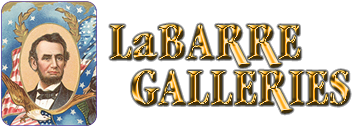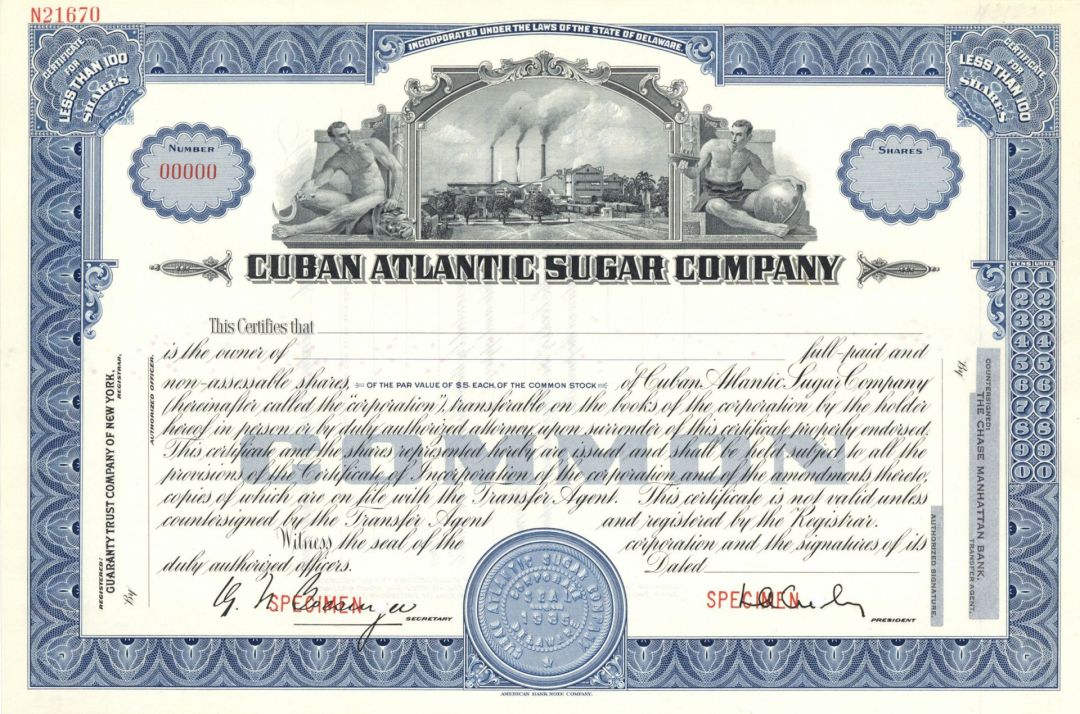Cuban Atlantic Sugar Co. - Cuba Specimen Stock Certificate
Inv# SE1593 Specimen StockSpecimen Stock printed by American Bank Note Company. Available in Blue or Red. Please specify color. In 1956, Loeb, Rhoades obtained a majority share in the Cuban Atlantic Sugar Company and divested its interest on December 31, 1958, just one day prior to the onset of the Cuban Revolution.
Cuban Atlantic Sugar Co. was a holding entity established in Delaware on March 1, 1935. It was owned by various New York banks as part of a settlement for claims totaling approximately $4.125 million against Cuba Cane Products Co., the successor to Cuba Cane Sugar Co. By 1939, Cuban Atlantic Sugar Co. had acquired eight sugar mills, with the first six operated through its subsidiary, Compañia Azucarera Atlantica del Golfo. Álava, originally founded in 1836 as Trapiche Regalado by Ignacio de Mendiola, was purchased by Julián de Zulueta Amondo in 1845, who transformed it into a central sugar mill. In 1915, it was acquired by Cuba Cane Sugar Co. from the Zulueta family. Conchita was established in 1823 by Bartolomé Casañas and, by 1880, had become one of the largest sugar mills in Cuba under the ownership of Domingo Aldama. In the early 1900s, it was owned by Juan Pedro Baró, who sold it for 3,500,000 pesos to José (Pote) Rodriguez in the 1910s. Rodriguez then sold it to Cuba Cane Sugar Co. in 1915 for 6,000,000 pesos. Mercedes was founded in 1855 by Antonio Carrillo Albornoz and was acquired in 1901 by Cia. Cubana Central Mercedes, whose main shareholders included Miguel Arango, Regino Truffin, and Ignacio Almagro. This mill was also purchased by Cuba Cane Sugar Co. in 1915. Lugareño was established in 1891 by Dr. Merchol Bernal Barona and Bernabé Sanchez Adán. Between 1908 and 1917, it was owned by Sociedad Anonima Central Lugareño, which was associated with Galbán & Cia. In 1916, it was acquired by Cuba Cane Sugar Co. Morón - Stewart was founded in 1906 with Cuban capital and financed by the Duncan Stewart Co. from Scotland, which manufactured its machinery. However, it faced financial difficulties and was soon acquired by The Stewart Sugar Co., which sold it to Cuba Cane Sugar Co. in 1915.
Perseverancia, founded in 1892 by the Spaniard Miguel Diaz Perez, was taken over by the Cuba Cane Sugar Company in 1915. Soledad's history traces back to the late 18th century when it operated a blood-driven mill. In 1814, it was purchased by Buenaventura Tojonera, who sold it in 1840 to Joaquín Aizpúrua, who transformed it into a central sugar mill. The Sécada family owned it until the late 1890s, after which it changed hands several times until 1919, when Alfredo Fernandez acquired it and subsequently sold it to the Cuba Cane Sugar Company in 1920. Milton S. Hershey (1857-1945) entered the Cuban sugar market in 1916 as part of his strategy to vertically integrate his Hershey Chocolate business, acquiring farmland in the Yumuri Valley, located approximately 30 miles east of Havana. The construction of Central Hershey was completed in time for the 1919 grinding season. Between 1916 and 1921, Hershey developed the 251-mile Hershey Cuban Railway, which was the only electric railway in Cuba. In its inaugural year, Central Hershey produced 32 million pounds of refined sugar, all of which was sold to the Hershey Chocolate Company in Pennsylvania.
In 1920, Hershey expanded his operations in Cuba by acquiring Central Rosario, followed by the acquisition of Central San Antonio in 1925. As production levels surpassed the capacity of the Pennsylvania chocolate company, surplus sugar was sold to various buyers, including the Coca-Cola Company in Atlanta. The political turmoil in Cuba during the 1930s and early 1940s prompted Hershey to contemplate the sale of his sugar mills in the country. Following his death in 1945, all of Hershey's assets in Cuba, which included 60,000 acres of land, three sugar mills, and a railway, were sold to the Cuban Atlantic Sugar Company for $18 million. In the 1946 Notice of Annual Meeting of Stockholders of the Cuban Atlantic Sugar Company, one of the agenda items was the acquisition of specific assets from the Hershey Trust Company, referred to as The Hershey Cuban Enterprises. This entity encompassed approximately 60,000 acres of land, four electric generating plants, and transmission lines, and included: The Hershey Corporation, a Delaware corporation that owned and operated Central Hershey, a significant sugar mill and refinery, as well as a peanut oil plant and a henequen (sisal) plant located adjacent to the sugar mill. The Hershey Corporation also managed two subsidiaries: Central Carmen S.A., a land holding company, and Compañia Agraria Cubana, which was inactive at that time. Additionally, there was the Hershey Sugar Sales Corporation, a Delaware corporation involved in purchasing refined sugar from Cuba through the Hershey Corporation and marketing it in the United States.
Rosario Sugar Company was a Cuban corporation that owned and operated Central Rosario. In June 1920, Hershey acquired Central Rosario from Ramón Pelayo for $8,000,000. Compañia Azucarera Gomez Mena was another Cuban corporation responsible for the ownership and operation of Central San Antonio. The Hershey Cuban Railway Company operated an electric railroad line spanning approximately 120 miles. Additionally, the Hershey Terminal Railroad was a Cuban corporation that served the eastern side of Havana Harbor, featuring 6 miles of track and a dock for lighter vessels and small boats. A documentary available on YouTube provides valuable insights into Hershey's investments and contributions to the Cuban sugar industry. The 1950 Annual Report of the Cuban Atlantic Sugar Co., dated September 30, 1950, informed stockholders that following the conclusion of the 1950 crop season, the company sold its two smallest sugar mills, Central Perseverancia and Central Soledad. The proceeds from these sales were partially utilized to acquire 28% of the outstanding shares of Central Violeta Sugar Co. SA, which owned Central Violeta and approximately 60,000 acres of land in Camagüey Province. The lands of Central Violeta Sugar Co. SA were adjacent to those of Central Morón, the largest sugar mill operated by Compañia Azucarera Atlantica del Golfo. The Annual Report also indicated that the Cuban Atlantic Sugar Co. managed two subsidiaries: Compañia Azucarera Atlantica del Golfo and Hershey Cuban Enterprises. In February 1956, Julio Lobo made an unsuccessful attempt to execute a hostile takeover of the Cuban Atlantic Sugar Co. Nearly two years later, on December 31, 1957, Lobo successfully completed the acquisition of the three Hershey mills from the Cuban Atlantic Sugar Co. through a Panamanian entity known as Chiriqui Sugar Mills Corp. The Cuban Atlantic Sugar Co. was ultimately liquidated in late 1958 following the completion of the sale to Chiriqui Sugar Mills Corp.
Stock and Bond Specimens are made and usually retained by a printer as a record of the contract with a client, generally with manuscript contract notes such as the quantity printed. Specimens are sometimes produced for use by the printing company's sales team as examples of the firm�s products. These are usually marked "Specimen" and have no serial numbers.











Ebay ID: labarre_galleries